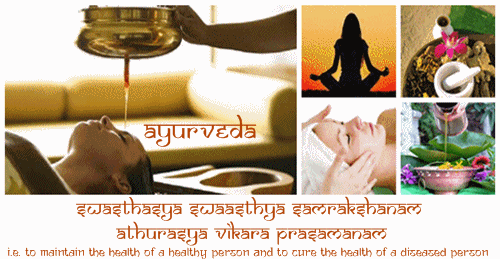
AYURVEDA
Considered by many scholars to be the oldest healing science, Ayurveda is a holistic approach to health that is designed to help people live long, healthy, and well balanced lives. The term Ayurveda is taken from the Sanskrit words ayur, meaning life or lifespan, and veda, meaning knowledge. It has been practiced in India for at least 5,000 years. Ayurveda is more than just a medical system. It follows the laws of nature to bring the individual back into equilibrium with their true life. It teaches us “how to live “or “how to lead a perfect life” or “how to maintain a healthy body and mind”. The basic principle of Ayurveda is to prevent and treat illness by maintaining balance in the body, mind, and consciousness through proper drinking, diet, and lifestyle, as well as herbal remedies.
Ayurveda derives medicine from the Nature. After thorough study, experimentation and documentation of hundreds of plants over thousands of years, India's ancient sages came to accurate conclusions about the efficacy of different plants and herbs. Although efficacy of Ayurveda for a variety of human ailments is well known in and around India, most of the world is not aware of the benefits that could be derived from this unique Indian system of medicine. Most of the Ayurvedic preparations are free from side effects or reactions. Ayurveda provides rational means for the treatment of many internal diseases which are considered to be obstinate and incurable in other systems of medicine.
Even with the presence of medical technology, many people still attest to Ayurveda’s effectuality. Modern medicine acknowledges Ayurveda as a form of alternative medicine.
HOW DOES IT WORK?
Just as everyone has a unique fingerprint, according to Ayurvedic beliefs, each person has a distinct pattern of energy -- a specific combination of physical, mental, and emotional characteristics. According to Ayurveda each individual has an innate constitution or dosha, which may either be vata, pitta, kapha, or a combination of any of the three. The main goal of Ayurvedic therapy is to maintain a healthy balance among these three doshas to bring about mental and physical well-being in an individual.
- VATA- energy that controls bodily functions associated with motion, including blood circulation, breathing, blinking, and heartbeat. When vata energy is balanced, there is creativity and vitality. Out of balance, vata produces fear and anxiety
- PITTA- energy that controls the body's metabolic systems, including digestion, absorption, nutrition, and temperature. In balance, pitta leads to contentment and intelligence. Out of balance, pitta can cause ulcers and arouse anger
- KAPHA- energy that controls growth in the body. It supplies water to all body parts, moisturizes the skin, and maintains the immune system. In balance, kapha is expressed as love and forgiveness. Out of balance, kapha leads to insecurity and envy
Everyone has vata, pitta, and kapha, but usually 1 or 2 are dominant in a particular person. Many things can disturb the energy balance, such as stress, an unhealthy diet, the weather, and strained family relationships. The disturbance shows up as disease. Ayurvedic practitioners prescribe treatments to bring the doshas back into balance.
From a Western medical perspective, stress relief seems to be one of the ways Ayurveda works to help fight illness. Studies have found that Ayurveda lowers anxiety, lowers blood pressure and cholesterol, slows the aging process, and speeds recovery from illness. Many herbs used in Ayurvedic medicine have antioxidant effects, which means that they may help protect against long term illnesses such, as heart disease and arthritis. Many Ayurvedic practitioners also recommend a vegetarian diet, which is believed to be better for your heart than diets containing red meat.
Ayurvedic Therapies can be used to treat ailments like Anxiety, Arthralgia, Asthma, Back pain, Diabetes, Disc Prolapse, Diseases of the eye, Dislocation, Dystonia, Hemiplegia, Hypertension, Impotence, Infertility, Miscarriage, Motor diseases, Multiple Sclerosis, Obesity, Peptic Ulcer, Peripheral Neuritis, Psoriasis and other skin diseases, Rheumatic Joint pains, Rheumatoid Arthritis etc. Apart from treatment for these diseases it also offers therapy that rejuvenates the body and mind from the ills arising out of the frictions of everyday life.
WHAT DOES A TYPICAL AYURVEDIC ASSESSMENT INVOLVE?
Ayurvedic treatment is tailored to each person’s ‘prakruti’ or constitution. Practitioners expect patients to be active participants because many Ayurvedic treatments require changes in diet, lifestyle, and habits. Ayurvedic treatment focuses on rebalancing your energies. An initial assessment with an Ayurvedic practitioner may last an hour or longer. A session begins with the practitioner taking a detailed medical history of the patient. He will check your pulse (unlike mainstream medicine, 12 different pulse points are assessed in Ayurveda), feel your abdomen, examine your tongue, eyes, nails, and skin, and listen to the tone of your voice. He will ask you questions regarding your appetite, bowel movements and other pertinent questions about your health, paying special attention to your lifestyle, diet, habits, and surroundings. The practitioner will then recommend ways to restore your natural dosha balance, which almost always includes changes in lifestyle, especially diet. Practitioners draw from more than 20 types of treatment, but the most commonly prescribed include:
- Pranayama- breathing exercises. Practicing pranayama helps you feel calm
- Abhyanga- rubbing the skin with herbal oil to increase blood circulation and draw toxins out of the body through the skin
- Rasayana- using mantras (repeated words or phrases) during meditation combined with certain herbs to rejuvenate a person
- Yoga- combining pranayama, movement, and meditation. Yoga has been shown to improve circulation and digestion, and to reduce blood pressure, cholesterol levels, anxiety, and chronic pain
- Pancha Karma- cleansing the body to purify it and reduce cholesterol. Practitioners use methods that cause sweat, bowel movements, and even vomit to cleanse the body of toxins
- Herbal medicines- prescribing herbs to restore dosha balance
HOW ARE AYURVEDIC PRACTITIONERS TRAINED?
In India, there are more than 150 undergraduate and 30 postgraduate colleges for Ayurveda, where training can involve up to five years of study.
Students who receive their Ayurvedic training in India can earn either a bachelor’s degree (Bachelor of Ayurvedic Medicine and Surgery, BAMS) or doctoral degree (Doctor of Ayurvedic Medicine and Surgery, DAMS) there. After graduation, some Ayurvedic practitioners choose to provide services in the United States or other countries
Currently, there are no national standards for the certification training or licensing Ayurvedic practitioners in the United States or Canada.

#IVF, #IVF in India, #Fertility Treatment, #Fertility Treatment Abroad, #Infertility, #Infertility Treatment Abroad, #Surrogacy, #Surrogacy in India, #Savings, #Affordable Healthcare, #ICSI, #ICSI in India, #India, #Paradigm Healthcare, #Medical Travel, #Medical Tourism, #Treatment Abroad, #Treatment in India, #Surgery, #Low Cost Surgery, #Best IVF, #Best Surrogacy, #IVF Clinic in India, #Rotunda, #Kaberi Banerjee, #Rita Bakshi, #International Fertility Centre, #Indira Hinduja, #Gautam Allahbadia, #Dr.Malpani, #Shivani Sachdev, #Nova Fertility, #Shweta Mittal, #Anoop Gupta, #Dr.Pai, #Fertility Specialist, #Doctors, #Surgeons, #Gay Surrogacy, #Highest Success Rate in IVF, #Highest Success Rate in Surrogacy, #Low Cost Surrogacy, #Best Prices, #Best Quality, #Egg-Donor, #PGD, #Pre-implantation Genetic Diagnosis
IVF | IVF in India | ICSI | IUI | Surrogacy | Surrogacy in India | Medical Travel | Medical Tourism
Ayurveda
Ayurvedic Treatment
